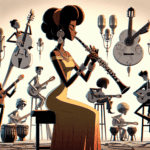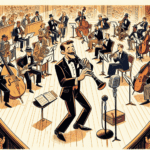The Clarinet's Journey into Jazz-Rock
The clarinet has always been a beloved instrument in music, but when it meshes with the electric vibes of jazz-rock, magic happens! This fusion brings a fresh dimension to familiar sounds. Imagine the warm, woody tones of the clarinet blending with electric guitars and funky bass lines. It's a musical treat that's hard to resist! Ready to explore how this woodwind fits into the jazzy-rock scene? You're in for an exciting ride.
Jazz-rock burst onto the scene in the late '60s and early '70s, shaking up the music world. Musicians began blending jazz improvisation with rock's raw energy, creating groundbreaking genres. The clarinet, typically associated with classical and traditional jazz, found a new home in this electric landscape. It brought a unique flavor that perfectly complemented the amped-up soundscape. Picture clarinet solos soaring over pounding drum beats and shimmering guitar riffs – it's a refreshing twist!
Jazz-Rock Timeline
| Year | Event |
|---|---|
| Late 1960s | Jazz-rock fusion emerges |
| Early 1970s | Clarinet begins to feature in jazz-rock compositions |
| 1980s-1990s | Jazz-rock evolves, incorporating more diverse influences |
| 2000s-Present | Modern clarinetists continue to push boundaries in jazz-rock |
Pioneers and Innovators
When talking about the clarinet's role in this genre, jazz legend Jimmy Giuffre often comes to mind. He wasn't just a player; he was a trailblazer who expanded jazz's horizons. His work with the Jimmy Giuffre 3 showcased the clarinet's improvisational prowess. Giuffre's sound was unique, blending soft, whisper-like notes that danced above the band's rhythm. His music created a rich sonic experience that mesmerized listeners!
But it's not all about the big names in jazz-rock. Let's shine a light on the rising stars! Contemporary clarinetists like Anat Cohen and Don Byron are building on past innovations and adding their own twist. They're mixing in elements from klezmer and world music, stretching what's possible with the clarinet. Their fresh take adds depth and variety to performances, thrilling audiences everywhere.
Techniques and Theory in Jazz-Rock Clarinet
Now, let's chat about the techniques players use when mixing clarinet with jazz-rock. Improvisation reigns supreme in this genre! Musicians take turns unleashing unique solos, spicing up the music and steering its direction. One cool technique to know is circular breathing. It lets a player make continuous sound without pausing for breath. This creates a flowing sound that seems to go on forever – pretty cool, right?
Music theory plays a big part too. Jazz-rock needs a good grasp of scales, chords, and rhythms. Getting comfortable with these ideas can really boost your playing. For example, knowing jazz standards gives you a great starting point for improvisation. This comes in handy when you're playing with a group and everyone's creating music on the spot!
Choosing Your Instrument
When you're jamming, having the right instrument can make all the difference. Let's talk clarinets! There are lots of brands out there, but Martin Freres, for example, is known for making quality instruments. The clarinet you choose can really affect your sound, especially when you're playing with a rock band! Good clarinets let you express yourself better, helping you create rich tones that can be heard over electric guitars.
Performance and Audience Engagement
Finally, let's talk about performing this fusion. A clarinetist doesn't just sit back and play; they connect with the audience. Whether it's through improvised solos or synchronized rhythms, this interaction adds an electric energy to live shows. As a performer, when you feel the music and inspire that same feeling in your audience, you can turn a good show into an unforgettable experience!
Wrapping It Up
Exploring the clarinet in jazz-rock is like opening a new book filled with musical adventures. It brings together the best of different musical worlds, showing off versatility, creativity, and explosive energy. So, grab your clarinet (maybe a Martin Freres if you're looking for quality), dive into improvisation, and hit those jazzy-rock stages. The music scene is ready for your unique sound to join the mix!







